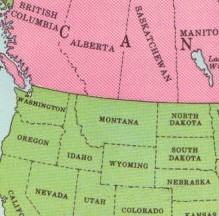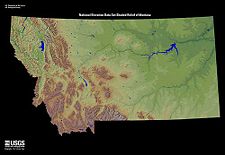Montana (U.S. state): Difference between revisions
(→Economy: write preliminary paragraph) |
(→Physiography (land forms): write preliminary paragraph) |
||
| Line 5: | Line 5: | ||
==Physiography (land forms)== | ==Physiography (land forms)== | ||
{{Image|Montana.jpg|right|225px|USGS shaded relief map of Montana}} | {{Image|Montana.jpg|right|225px|USGS shaded relief map of Montana}} | ||
Montana straddles the [[Great Plains]] in the eastern portion of the state and the [[Rocky Mountains]] to the west. The [[Continental Divide]] runs north to south through the western Rockies. The principle rivers are the [[Missouri River]] which ultimately empties into the [[Gulf of Mexico]] and the [[Yellowstone River]] which is a tributary of the Missouri. | |||
==Physiography== | ==Physiography== | ||
Revision as of 12:10, 6 November 2022
Montana is one of the constituent states of the United States of America. Montana has an area of 147,046 square miles (380,848 square kilometers) and a population of 1,084.225 (2020 census). It joined the Union on November 8, 1889 as the 41st state. It's capital is Helena is the capital of Montana.
Physiography (land forms)
Montana straddles the Great Plains in the eastern portion of the state and the Rocky Mountains to the west. The Continental Divide runs north to south through the western Rockies. The principle rivers are the Missouri River which ultimately empties into the Gulf of Mexico and the Yellowstone River which is a tributary of the Missouri.
Physiography
Climate
Economy
Currently, tourism ranks as one of the most important economic activities in the state. Apart from Glacier National Park and Little Bighorn National Monument, the site of Custer's Last Stand, the state offers skiing, hiking and camping in the Rocky Mountain west and elsewhere.

